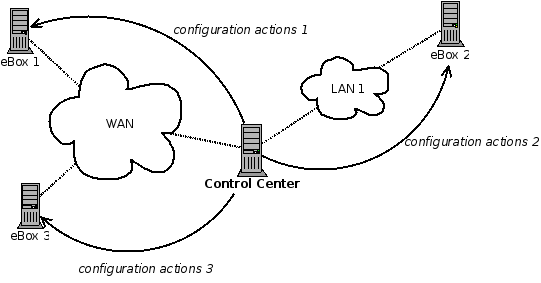Table of Contents
The eBox control center is intended to manage simultaneously several eBoxes at the same time using a very secure channel to communicate the center with the sparse eBoxes. The Figure 19.1 indicates how a single element, the Control Center, can send instructions, basically actions which every eBox module may perform and expose in its public API, which each eBox performs independently answering back with a response to the control center when the action has been accomplished.
In order to provide a secure connection, a Virtual Private
Network (VPN) is used as link layer and Secure HyperText
Transfer Protocol (HTTPS) as transport layer. This dual lock
assures the communication between the control center and its
eBoxes is protected and the performance is not really decreased
as the required bandwidth to set a system configuration can be
considered minimal.
Over HTTPS, SOAP protocol is used to exchange XML-based messages between the control center and the eBox's group. The message pattern is a remote procedure call (RPC) one which the control center asks the eBoxes to do something and the eBox responds immediately. An answer may be given back. Furthermore, a state is also provided since a remote eBox "object" is handled to exchanges the messages that allows the control center manager set a configuration and then save changes in a single SOAP session.
The communication among the elements may be full duplex. The control center send actions to be performed by the eBox's group and, on the other hand, every eBox can send information about itself or any of its services using the eBox event framework. This information is gathered into the log system which could be better exploited in the future to supervise several eBoxes at one time.
